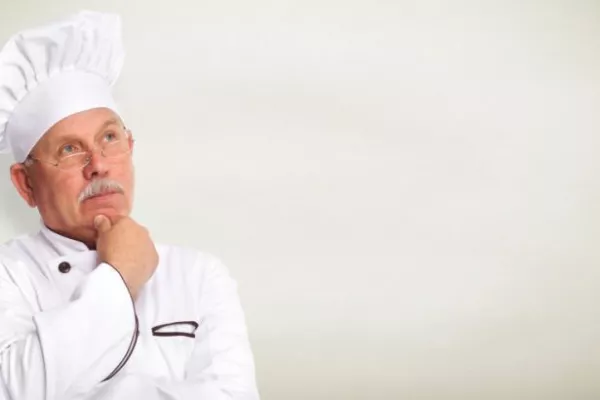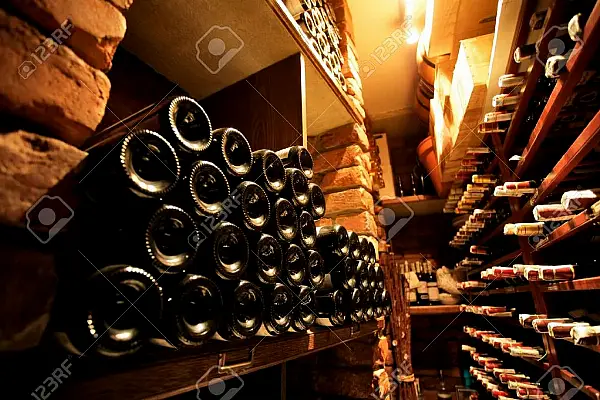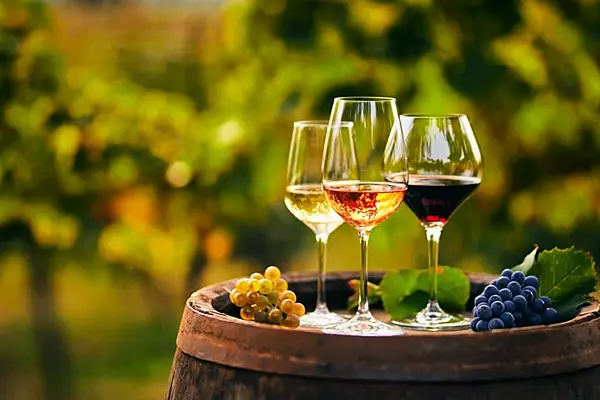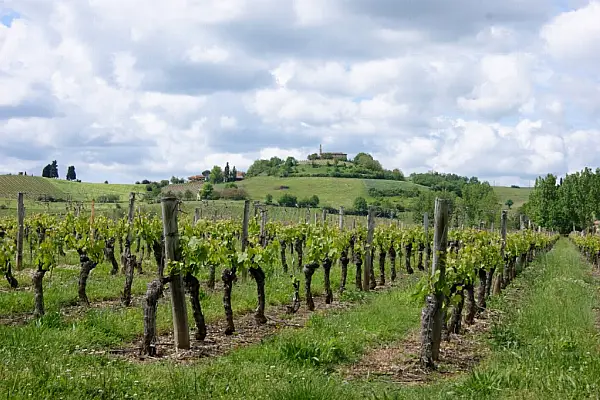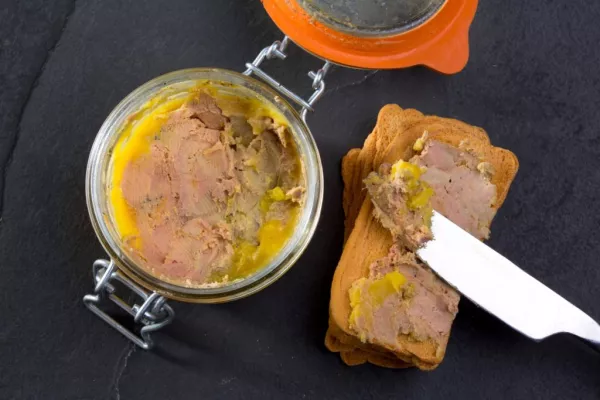So, American person, you think you ate a lot at Thanksgiving? You probably did. By most accounts the average Thanksgiving meal clocks in at about 4,500 calories. And that doesn’t count all the beer, whiskey and cider you might have been consuming. Or the potato chip salad you could have made.
That's merely an average day of eating for chefs Shane McBride and Daniel “Chino” Parilla when they're researching a restaurant. At least it was when the pair went on a tour of some of Paris and Lyon's most classic restaurants in preparation for the wondrous new New York restaurant Augustine, that they opened with legendary restaurateur Keith McNally. Over the course of 10 days, McBride and Parilla ate some of France's most famous dishes. They estimate that in the course of their research, they consumed some 75,000 calories worth of food.
If you want to recreate the chefs' epic culinary adventure in the two capitals of French cuisine, the blueprint is below. Just remember to pack loose fitting clothing. And bon appetit.
Day 1, Paris
Le Voltaire, LunchThis uber classic bistro is right off the Seine, close by the Louvre, and boasts red velvet curtains, soft lighting and mainstays of French cuisine.
Key Dishes: Salade Gourmande, a composed salad with foie gras; entrecote with bordelaise sauce; escargot; apple tart tatin with a pot of whipped crème fraîche.
Takeaway: “The Salade Gourmande shaped the one we serve at Augustine now," says McBride. "And we wanted to do a version of their entrecote: It’s a thin rib-eye, quickly grilled and gratineed with bone marrow on top. It kept getting side swiped when we did at tastings at the restaurant but we still might put it on; it's delicious.”
L’Ami Louis, Dinner
This quintessentially old school Paris restaurant is notorious for its brusque service (they've been known to politely take your coat, then toss it up on a rack), the dangerous trip down the steep stairs to the bathroom and oddball decor, like jelly jar water glasses with Star Wars icons on them. The menu is a pricey roundup of the greatest hits of classic French cooking.
Key Dishes: Foie gras terrine; escargot; roast chicken for two; cote de beouf; berries with crème fraiche
Takeaway: “You start with foie gras terrine—four thick slices, the size of my hand, and I have pretty big hands," relates McBride. "It's served with a towering pile of buttered toast and then you get a pot of butter alongside. That dish alone is 2,000 calories. ”
Day 2Restaurant Clover, Lunch
A stylish—both in design and crowd—and tiny restaurant with a modern French-Asian menu, this is a star of the Left Bank. Running the show from the open kitchen is Michelin-starred chef Jean Francois Piège.
Key Dishes: The tasting menu changes frequently and includes dishes like Thai flavored beef salad; steamed fish in nasturtium juice; scallop pavé; just-baked chocolate chip cookie.
Takeaway: “A very artful meal," is how McBride describes it. "The highlight was scallop pavé. We said, ‘what?’ Pavé means brick in French– he’s serving a scallop brick? But the chef cooks scallops on a cobblestone brick sourced from a Paris street. Very cool.”
Au Passage, Dinner
Set in an alley in the unfancy 11th Arrondisement, this is one of Paris’s stand-out natural wine bars. There's a small plates chalkboard menu and lots of charcuterie and cheese.
Key Dishes: Roast rabbit leg on cabbage; grilled octopus.
Takeaway: “The most hipster restaurant we went to, it’s very Brooklyn," says McBride. "I’d label the food French tapas. I think this is the only place we went to that didn't serve steak. But lots of exciting, inexpensive natural wines. And probably our most affordable meal."
Day 3Le Comptoir, dinner (and lunch)
A brilliant hotel restaurant from a star of new French cooking, Yves Camdeborde. (The chef owns the hotel.) At lunch and for Sunday supper, the restaurant features updated versions of French classics. The other nights, the menu features a more freewheeling gourmet menu. There are no reservations and there’s always a line.
Key Dishes: Croque Monsieur, very thin crispy and cheesy; truffled cheese and leek omelet. During the Sunday night supper, don't miss the radishes with butter, oeufs mayonnaise, salade gourmande, and exceptionally tender pigs foot with lentils and mashed potatoes.
Takeaway: Says McBride: “We ate at Le Comptoir three times on this trip. Twice for dinner, once for lunch. We cancelled our meal at Robuchon Atelier to go there one more time. The Sunday supper is standout; this was the best salade gourmande, also a big influence on the one at Augustine." "This was maybe 3500 calorie meal," adds Parilla. “Worth every one of them.”
“I also logged some time at the Comptoir wine bar,” continues McBride. “It looks like a butcher shop, they serve killer natural wines and foie gras terrine and the best Bayonne ham I ever had.” “I was taking a nap,” says Parilla.
Day 4
Frenchie, Dinner
This superb luxe comfort food tasting menu restaurant is a globally popular hotspot in the second arrondisement. The restaurant’s name comes from a nickname Jamie Oliver gave to French-born chef Gregory Marchand (who also cooked at Gramercy Tavern in New York) when Marchand worked for the star British chef.
Key Dishes: Foie gras terrine with pork gelee; lentils with truffles; gnudi with truffles; roasted turbot.
Takeaway: “We had a 12 course tasting menu and everything was perfectly executed," says McBride. "We tried to go to Frenchie wine bar—twice—but it was too packed. So we hung out with chef at his sandwich shop, smoking cigars. We didn’t get to eat there, but we heard a lot about their smoked brisket, and housemade hot dogs.”
Day 5Robert et Louise, Lunch.
This compact, idiosyncratic meat-focused restaurant in Paris's 3rd arrondisement feels like you walked into someone's cabin, with wood-beamed ceilings and a wide open kitchen. The cooking is done on a plancha style griddle on an open hearth and tables are set with jars of cornichons and mustard.
Key Dishes: Salade gourmand; blood sausage; contre filet (beef filet); crispy hash brown style potatoes.
Takeaway: "It's cool to see this dude cooking your food on a fire right in front of you. The steak comes right off the griddle, and along with it, this chunky potatoes that have been cooking in the fat alongside it."
Day 6Compagnie des Vins Surnaturels, Snacks
A cozy wine bar with an idiosyncratic list of over 3,000 bottles, well located in the 6th arrondisement. (There are branches in New York City and London, too).
Key Dishes: Hams. Cheeses. And wine.
Food: “Believe it or not, I went here almost every night,” says McBride. “After dinner. Their hams are gorgeous.”
Day 8
La Cigale Recamier, Lunch
On a side street in the 6th Arrondisement, Recamier looks like the quintessential Paris restaurant (awnings, outdoor seating separated from the street by a wall of greenery). But the menu is dedicated to one dish and that's the soufflé.
Key Dishes: Believe it or not, their menu changes seasonally—in the fall, you might find mushroom and buckwheat soufflé. No matter what, order the classic cheese soufflé.
Takeaway; "We’ve been on a quest for the perfect cheese soufflé since we opened Cherche Midi," says McBride. "This was spot on; it inspired Augustine's soufflé. But they have a lot of different soufflés: blue cheese; seafood; red pepper with harissa. They were definitely thinking outside the soufflé box.”
Restaurant Sebillon, Dinner
A 100-plus-year-old temple devoted to lamb in Neuilly, outside central Paris.
Key Dishes: Oysters; lamb (as much as you can eat) with navy beans; eclair; baba au rhum.
Takeaway: Here’s McBride: “There’s a little old guy shucking oysters outside, which is so old school. But the main event is the leg of lamb. It’s roasted on the bone, presented on an old school trolley, expertly sliced tableside. The servers could do it blindfolded, they’re so good. For dessert: Baba au rhum. They pour a little bit of rum—and it’s St. James, from Cuba—on the cake, and then they set the bottle on the table. That’s classy. We do that now at Augustine."
Day 9, Lyon
Paul Bocuse, dinner
The legendary restaurant from the godfathers of French cuisine in the modern world. The place has been called cliché and old fashioned by any number of critics, but for most notable chefs it epitomizes the foundation of French cooking; it’s their Hall of Fame.
Key Dishes: The grand tasting menu includes: Truffle soup; scallop with foie gras and potato galatte; Chicken en Vessie; the cheese course; crêpes Suzette; ile flottante (meringues in custard).
Takeaway: “It was like walking into my dream,” says McBride. “The building is awesome, it’s decorated with paintings of famous chefs throughout time. People who tell you it’s cheesy are wrong. If you’re a chef, it’s our history.
“Start with a glass of Dom Perignon. What else would you start with? The grand tasting menu is hit after hit after hit of perfectly executed classics. The truffle soup comes in a lion's head bowl, a rich consommé chock full of truffles and a dome of pastry on top; it's the Bocuse signature. Second only to the most well known dish, which is the Bresse Chicken en Vessie: It’s the top of the line chicken, stuffed with foie gras and truffles and cooked in a pig’s bladder which acts as a protective coating for it. A team of waiters present the dish to you tableside, they pop the bladder like it’s a balloon and then carve the chicken up like a boss.”
“Then up rolls 3 trolleys of cheese,” continues Parilla. “One of them is just goat cheese. Epic. And then comes the dessert trolley. You’re on a big food high afterwards.”
“The bill is epic, too,” says McBride. It was over $1000. I have the receipt hanging in my office.”
Total Calories for the Trip: 75,000. "These are the highlights," explains McBride. "I'm not counting the poutine from the crappy Canadian pub where I went on Superbowl Sunday, or the baguettes with all the butter we ate every day. Or the calories from all the wine. In fact, this might be a conservative estimate."
News by Bloomberg, edited by Hospitality Ireland
